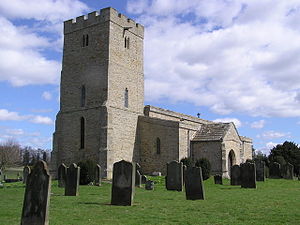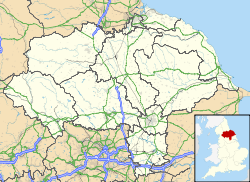- St John the Baptist's Church, Stanwick
-
St John the Baptist's Church, Stanwick 
St John the Baptist's Church, Stanwick, from the southeastLocation in North Yorkshire Coordinates: 54°30′10″N 1°42′56″W / 54.5028°N 1.7156°W OS grid reference NZ 185 119 Location Stanwick St John, North Yorkshire Country England Denomination Anglican Website Churches Conservation Trust History Dedication John the Baptist Architecture Functional status Redundant Heritage designation Grade I Designated 4 February 1969 Architect(s) Anthony Salvin (1868 restoration) Architectural type Church Style Gothic, Gothic Revival Completed 1868 Specifications Materials Stone rubble, roofs in stone slate, artificial stone slate and lead St John the Baptist's Church, Stanwick, is a redundant Anglican church in the village of Stanwick St John, North Yorkshire, England (grid reference NZ 185 119). It has been designated by English Heritage as a Grade I listed building,[1] and is under the care of the Churches Conservation Trust.[2] The church is also recognised as a Scheduled Monument,[3] and it stands within the earthworks of Stanwick Camp,[2] a settlement originating in the early Iron Age.[4]
Contents
History
The present church dates from the 13th century,[1] although the discovery of a 9th-century cross shaft in the churchyard suggests that there was an earlier church on the site.[2] It was "heavily restored" in 1868 by Anthony Salvin.[1] St John's was vested in the Trust on 1 June 1990.[5]
Architecture
Structure
The church is constructed in stone rubble, and the roofs are in stone slate, artificial stone slate and lead. Its plan consists of a four-bay nave with a south aisle and a south porch, a three-bay chancel with a north vestry that was added in the 19th century, and a west tower. The tower is in three stages, and has quoins and stepped diagonal buttresses. In the lowest stage, the west face has a lancet window above a central buttress, and there is a similar lancet window on each face in the middle stage. In the top stage are two-light bell openings, and the summit has a battlemented parapet. On the ground, on the west side, is a medieval stone coffin lying on its side. On the north side is a five-sided stair turret that was added in the 19th century. The porch has stepped diagonal buttresses, and an arched doorway over which is a sundial. The inner door dates from the 13th century. Incorporated in the fabric of the south aisle are carved stones dating from the Anglo-Saxon and medieval periods. It has a 19th-century single-light west window, two three-light windows in the south wall dating from the 19th century and a three-light, 13th-century east window. In the north wall of the church are three two-light windows containing Decorated and Perpendicular tracery. The chancel contains a priest's doorway and a number of windows, including a three-light east window with Decorated tracery. The vestry has a two-light 19th-century window. Internally there is a four-bay south arcade, a tower arch and a chancel arch.[1]
Fittings and furniture
In the north wall of the chancel is a recumbent effigy and in the south wall is a 19th-century piscina and a stepped triple sedilia. In the south aisle is another piscina and an aumbry. The font dates from the 19th century and has a 17th-century carved canopy. The church contains a number of tombs and monuments to the memory of the Smithson family. On the east wall of the chancel are boards painted with the Lord's Prayer, Creeds, and the Commandments. Over the chancel arch are the royal arms of George III, and around the church are hatchments.[1] The organ was built in 1866 by John Fincham of London.[6] The ring consists of three bells, all cast by Samuel I. Smith, two in 1677, and the third in 1685.[7]
External features
In the environs of the church are seven structures each of which is designated as a Grade II listed building. To the south of the south aisle are four sandstone tombstones dating from the 18th century,[8] and on the east side of the porch is another group of four tombstones from the same period.[9] To the south of the porch are two memorials, one to William Newcomb who died in 1752,[10] and the other to Richard Slater dating from the early 18th century.[11] South of the chancel is an Anglo-Saxon cross-shaft dating probably from the 9th century.[12] To the north-northeast of the church are two wells built in the late 19th century for the Duke of Northumberland and possibly designed by Anthony Salvin. The smaller one is some 150 metres from the church around a spring,[13] and this feeds the other well about 100 metres from the church.[14]
See also
- Grade I listed buildings in North Yorkshire
- List of churches preserved by the Churches Conservation Trust in Northern England
References
Note: The Heritage Gateway website is published by the Heritage Gateway Partners, namely English Heritage, the Institute of Historic Building Conservation, and The Association of Local Government Archaeological Officers (ALGAO:England)
- ^ a b c d e "St John the Baptist, Stanwick", Heritage Gateway website, 2006, http://www.heritagegateway.org.uk/Gateway/Results_Single.aspx?uid=323396&resourceID=5, retrieved 13 August 2010
- ^ a b c Church of St John the Baptist, Stanwick, North Yorkshire, Churches Conservation Trust, http://www.visitchurches.org.uk/Ourchurches/Completelistofchurches/Church-of-St-John-the-Baptist-Stanwick-North-Yorkshire/, retrieved 25 March 2011
- ^ "Church of St John the Baptist Stanwick, North Yorkshire", Heritage Gateway website, 2006, http://www.heritagegateway.org.uk/Gateway/Results_Single.aspx?uid=MNY24964&resourceID=1009, retrieved 23 August 2010
- ^ "Stanwick Camp, Ditch and bank", Heritage Gateway website, 2006, http://www.heritagegateway.org.uk/Gateway/Results_Single.aspx?uid=MNY24128&resourceID=1009, retrieved 24 August 2010
- ^ (PDF) Diocese of Ripon and Leeds: All Schemes, Church Commissioners/Statistics, Church of England, 2010, p. 5, http://www.churchofengland.org/media/56475/riponandleeds.pdf, retrieved 3 April 2011
- ^ Yorkshire, North Riding (Yorkshire, North), Stanwick St. John, British Institute of Organ Studies, http://www.npor.org.uk/cgi-bin/Rsearch.cgi?Fn=Rsearch&rec_index=N15045, retrieved 24 August 2010
- ^ Stanwick St John S John Bapt, Dove's Guide for Church Bell Ringers, http://dove.cccbr.org.uk/detail.php?searchString=stanwick&Submit=+Go+&DoveID=STANWICK+S, retrieved 24 August 2010
- ^ "4 tombstones in a line approximately 5 metres south of south-west of the Church of St John the Baptist, Stanwick", Heritage Gateway website, 2006, http://www.heritagegateway.org.uk/Gateway/Results_Single.aspx?uid=323397&resourceID=5, retrieved 23 August 2010
- ^ "Group of 4 tombstones approximately 2 metres east of porch of Church of St John", Heritage Gateway website, 2006, http://www.heritagegateway.org.uk/Gateway/Results_Single.aspx?uid=323400&resourceID=5, retrieved 24 August 2010
- ^ "Newcomb memorial approximately 7 metres south of porch of the Church of St John the Baptist, Stanwick", Heritage Gateway website, 2006, http://www.heritagegateway.org.uk/Gateway/Results_Single.aspx?uid=323398&resourceID=5, retrieved 23 August 2010
- ^ "Slater memorial approximately 6 metres south of porch of Church of St John the Baptist", Heritage Gateway website, 2006, http://www.heritagegateway.org.uk/Gateway/Results_Single.aspx?uid=323399&resourceID=5, retrieved 24 August 2010
- ^ "Saxon cross-shaft approximately 3 metres south of chancel of Church of St John the Baptist", Heritage Gateway website, 2006, http://www.heritagegateway.org.uk/Gateway/Results_Single.aspx?uid=323401&resourceID=5, retrieved 24 August 2010
- ^ "Well approximately 150 metres north-north-east St John the Baptist", Heritage Gateway website, 2006, http://www.heritagegateway.org.uk/Gateway/Results_Single.aspx?uid=323403&resourceID=5, retrieved 24 August 2010
- ^ "Well approximately 100 metres north-north-east of Church of St John the Baptist", Heritage Gateway website, 2006, http://www.heritagegateway.org.uk/Gateway/Results_Single.aspx?uid=323402&resourceID=5, retrieved 24 August 2010
External links
Categories:- Grade I listed buildings in North Yorkshire
- 13th-century architecture
- 13th-century church buildings
- 1868 architecture
- 19th-century Anglican church buildings
- Gothic Revival architecture in North Yorkshire
- English Gothic architecture
- Churches preserved by the Churches Conservation Trust
- Scheduled Ancient Monuments in North Yorkshire
Wikimedia Foundation. 2010.

